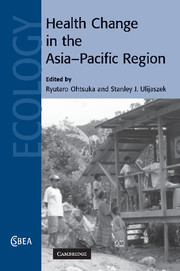Book contents
- Frontmatter
- Contents
- List of contributors
- Acknowledgements
- 1 Health change in the Asia-Pacific region: disparate end-points?
- 2 Interactions of nutrition, genetics and infectious disease in the Pacific: implications for prehistoric migrations
- 3 Biocultural adaptation and population connectedness in the Asia-Pacific region
- 4 Changing nutritional health in South East Asia
- 5 Obesity and nutritional health in Hong Kong Chinese people
- 6 Modernization, nutritional adaptability and health in Papua New Guinea Highlanders and Solomon Islanders
- 7 Tongan obesity: causes and consequences
- 8 Nutrition and health in modernizing Samoans: temporal trends and adaptive perspectives
- 9 Health patterns of Pacific Islanders and Asians in the United States
- 10 Impacts of modernization and transnationalism on nutritional health of Cook Islanders
- 11 Mortality decline in the Pacific: economic development and other explanations
- 12 Health changes in Papua New Guinea: from adaptation to double jeopardy?
- Index
- References
5 - Obesity and nutritional health in Hong Kong Chinese people
Published online by Cambridge University Press: 15 September 2009
- Frontmatter
- Contents
- List of contributors
- Acknowledgements
- 1 Health change in the Asia-Pacific region: disparate end-points?
- 2 Interactions of nutrition, genetics and infectious disease in the Pacific: implications for prehistoric migrations
- 3 Biocultural adaptation and population connectedness in the Asia-Pacific region
- 4 Changing nutritional health in South East Asia
- 5 Obesity and nutritional health in Hong Kong Chinese people
- 6 Modernization, nutritional adaptability and health in Papua New Guinea Highlanders and Solomon Islanders
- 7 Tongan obesity: causes and consequences
- 8 Nutrition and health in modernizing Samoans: temporal trends and adaptive perspectives
- 9 Health patterns of Pacific Islanders and Asians in the United States
- 10 Impacts of modernization and transnationalism on nutritional health of Cook Islanders
- 11 Mortality decline in the Pacific: economic development and other explanations
- 12 Health changes in Papua New Guinea: from adaptation to double jeopardy?
- Index
- References
Summary
Introduction
Obesity is a major health problem in the Asia-Pacific region and elsewhere because of its increasing prevalence and the morbidity and mortality associated with it (Seidell et al. 1996; World Health Organization 1998; Behn and Ur 2006). The prognostic significance of obesity in cardiovascular disease and total mortality is mainly due to its close associations with hypertension, dyslipidaemia, hyperinsulinaemia and glucose intolerance (Sowers 2003; Bray 2004; Behn and Ur 2006). There are also close associations between various anthropometric measures of body fatness, including body mass index (BMI), waist–hip ratio (WHR) and waist circumference (WC), and multiple cardiovascular risk factors. Most of these relationships are independent of age and smoking, and some of the risk factors increase in severity exponentially with increase in fatness and obesity.
Western definitions of obesity, if used to determine levels in Asian populations, give much lower prevalences than among European and North American populations. For example, if a BMI ≥ 30 kg/m2 is used to define obesity, up to 25% of Europeans but only 2% to 5% of Hong Kong Chinese will be classified as obese (Ko et al. 1999a; Rossner 2002). However, there is now a wealth of data showing that the prevalences of both type 2 diabetes and hypertension are reaching epidemic proportions among Asians, despite currently low prevalence rates of obesity, as defined as BMI greater than 30 kg/m2, in all nations of Asia.
- Type
- Chapter
- Information
- Health Change in the Asia-Pacific Region , pp. 88 - 100Publisher: Cambridge University PressPrint publication year: 2007



